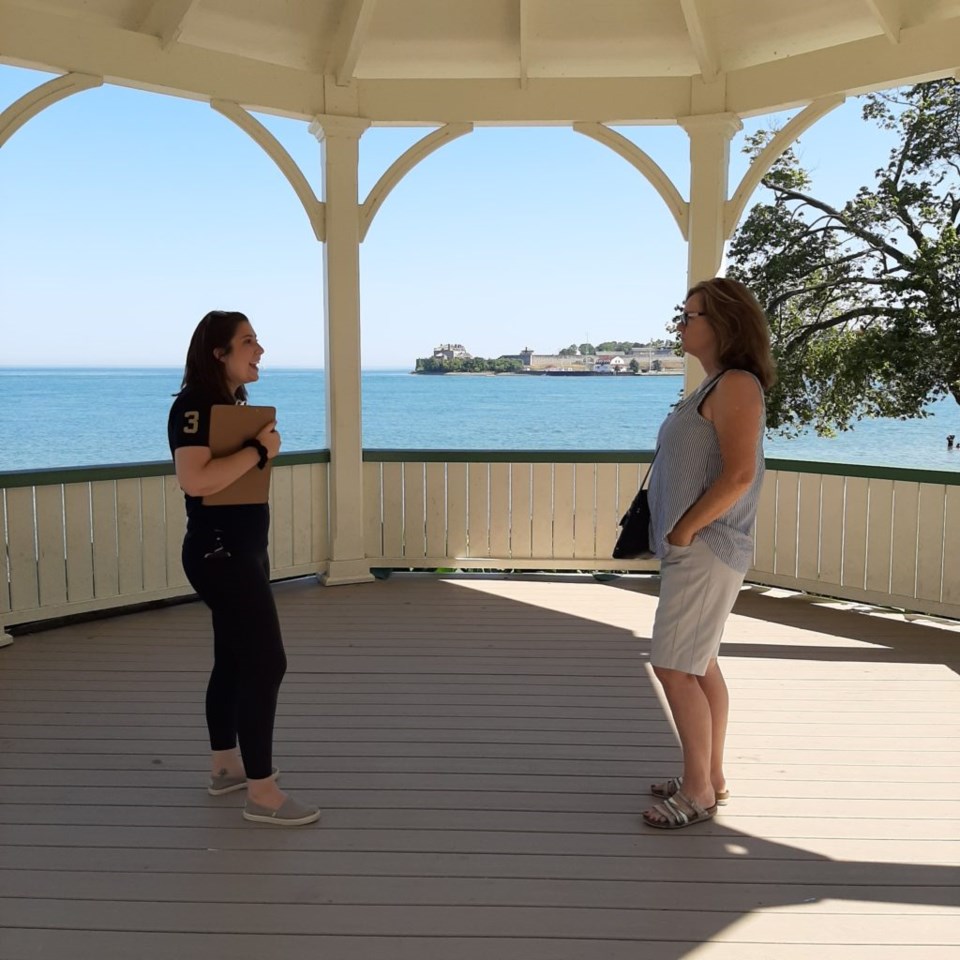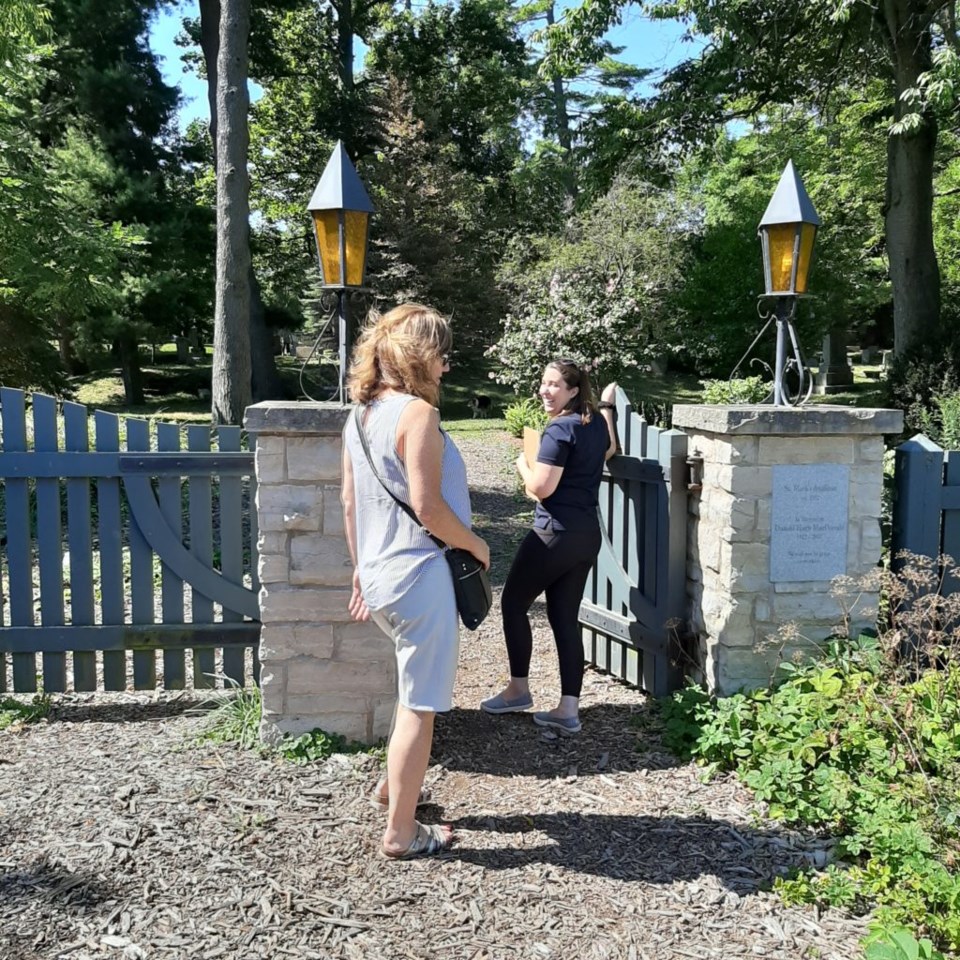
There is always a feeling you get from being in a physical place where something significant happened.
We can read about history in books, participate on line chats or presentations but there is something distinct about being in the actual site where an event took place, where you can soak up the atmosphere. We long to feel the history of a place, imagine what it was like in times long past and connect to the stories of those who came before us.
Lately many of us have been so isolated, cooped up in our own homes, centred on our own lives and the present pandemic that we haven’t given the past much thought. Yet, at the Niagara-on-the-Lake Museum, the past is their present. On a gorgeous Sunday afternoon, three people gathered at the gazebo by the mouth of the Niagara River to soak up the history in our own back yard.
Shawna Butts, assistant curator and educational programmer from the museum began the tour at the gazebo for a specific reason. “We like to start our tours off at the gazebo because it allows us to place NOTL a bit more in historical context than if we start at the museum on Castlereagh Street. That’s because the Niagara River and the fort across the way, which is Fort Niagara, is very important to the founding of our community.”
As the small group gazed over at Fort Niagara and the impressive French Castle, Butts recounted the history of the fort going back to when the French built it to use as a strategic outpost in order to control the mouth of the Niagara River. After the Seven Years’ War, the British took control of the fort. However, on this side of the river, the territory was still under French control.
She explained that since the fort was captured by Col. John Butler and Butler’s Rangers, it remained under British control during the American Revolution. At this time, the fort began to be overwhelmed with refugees. Eventually, the Butler’s Rangers came to this side of the river to start planting food to feed the people at the fort. This is when we get our first settlers, from 1779 to 1780. The American Revolutionary War ended in 1783, and the British had to give up the fort to the Americans.
Butts points out, “That is the American side of the river. A lot of tourists first don’t realize that, and they look out and say, ‘Oh! That’s Fort George!’” No, she tells them, that is the American side with Fort Niagara. Fort George is up the way.
By 1791, the colony was split into Upper and Lower Canada. This area, previously known as Butlersburg, was renamed Newark by Governor John Graves Simcoe, and became the capital of Upper Canada. It remained the capital until 1796, when it moved across the lake to York (Toronto) because of our proximity to the U.S. Butts reminds us that, “we are within cannon-fire, currently where we are standing.” The proximity of Fort Niagara also serves as a reminder of how close we are to the Americans, and how our histories or so interconnected.
Queens Royal Park was also the site of a lavish hotel built in 1868. This first-class hotel was complete with lawn bowling and tennis courts, and a guest list that included the Prince of Wales, who became King George V. The hotel was demolished in 1930, and the town bought the property and built the park.
Butts adds a story about the gazebo itself, that was built as part of a set for the 1983, Stephen King movie, The Dead Zone. Over the years since the movie, she continues with a sparkle in her eye, the gazebo has been the stage for many romantic scenes, such as wedding photos, rather than the stage of a grisly murder as depicted in the movie.
She also points to the beach below the gazebo as the site where the famous lake-crossing swims that start from the Queens Royal Park beach and end at Marilyn Bell Park in Toronto. This year the swims were cancelled due to COVID-19 restrictions.
Butts concludes this part of the tour by reiterating why the vantage point from the gazebo helps to set the scene for the tour. “It really brings the history of NOTL as to why our community is here today, and really shows you the proximity to the United States. Especially when we talk about the War of 1812, and you can really see how close we are and the effects of it.”
The tour route from the gazebo was altered due to COVID-19, and the need to physical distance and avoid larger crowds in the process. Each tour is different, depending on who is your guide for the walk, but each guide includes certain stops, one being a walk through St. Mark’s Anglican Church cemetery.

As the tour walks through the small wooden gate to the rear of the cemetery, Butts explains it is the oldest burial ground in town. The Anglican church was the only one established in 1792, so all the burials at that time were at St. Mark’s. The church bells toll as she recounts the story of Elizabeth Kerr, the daughter of Sir William Johnson and Molly Brant, who died in NOTL in 1794, and is buried in the oldest grave in the cemetery.
Like standing at the gazebo, being in St. Mark’s cemetery itself, is a remarkable experience. Listening to Butts tell the stories of the people buried here and describe life in the past, coupled with feeling the cool breeze under the canopy of trees, smelling the flowers and vegetation in the air, and seeing the graves, makes history feel more alive. Kerr’s story is in the museum’s forthcoming book about the Women of Niagara-on-the-Lake. Butts leads the group throughout the town, down King Street to the Masonic Lodge, over to Prideaux Street to the Promenade House and up Regent Street to the Voices of Freedom Park, down Johnson Street, and ending up back at the museum.
Unfortunately, this tour was Butts’ first and last historical walking tour of the season; her first because she stepped in to cover the tour in absence of the usual volunteers, and last because the museum is cancelling the tours for September due to lack of interest. She assures the group the tours will return next year. However, the museum does have other upcoming events.
On Monday, Aug. 31, along with Executive Catering Niagara, the public is invited to support the NOTL Museum while enjoying the beauty of the Ravine Vineyard Estate Winery. The $55 ticket includes a three-course meal, plus a $20 tax receipt for a donation to the museum.
The museum invites ticket holders to come enjoy a lunch or dinner picnic under the beautiful tent overlooking the vineyard, with live music and great company. Tables seat up to six, so you can put together a group within your bubble and enjoy a pleasant experience. The menu is posted on the museum website at nhsm.ca, along with information for ticket purchases or by calling 905-468-3912 or [email protected].


